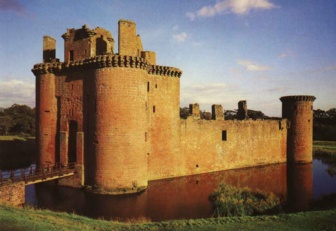Clan Maxwell Society
Celebrating the Scottish Heritage of Maxwells and their Allied Families
Adair • Blackstock • Dinwiddie/Dinwoodie/Dinswoodie • Edgar • Herries • Kirl • Kirkland • Latimore/Latimer • MacKittrick • Maxton • Monreith • Moss • Nithsdale • Peacock • Pollock/Pollok • Polk/Paulk • Rawlins • Sturgeon • Wardlaw
Americans Recreate Historic Siege Engine


Seven hundred years after a war machine nicknamed Warwolf was used by King Edward I to conquer Caerlaverock Castle, American scholars recreated the ancient weapon for display at the historic Maxwell landmark. A recent British television documentary followed the trials and tribulations of two teams of mediaeval scholars as they attempted to authentically recreate the machine used by Edward I.
The 1300 siege of Caerlaverock Castle, in Dumfriesshire, is one of the most celebrated incidents in Maxwell history. The castle housed a Scots garrison which harassed English-held Lochmaben, and Edward I went out of his way to take Caerlaverock through a siege. The author of a contemporary Anglo-Norman ballad wrote: “Caerlaverock was so strong a castle that it feared no siege before the King came there….” The defenders of Caerlaverock, in their lack of fear, did not realize that Edward’s engineers had built a huge trebuchet which would ultimately bring the castle into his hands. The trebuchet, nicknamed Warwolf, was a terrifying siege machine capable of hurling ninety 200-pound missiles to smash through the castle walls.
The men who built such siege machines were professionals, expert engineers and carpenters, and by the end of the 12th century they had discovered that putting a heavy counterweight on the end of a beam allowed energy to be stored in the counterweight. No pull was needed to release it, only to cock it. That type of machine was called a Trebuchet, and it appeared in the west in the early 13th century.
The next change was to abandon the fixed counterweight on the end of the beam, and in its place have a swinging box. There were various advantages to this. With a fixed counterweight, it was hard to change its weight, so the machine would always shoot at the same speed and each projectile of the same weight would land in the same place. To alter range, the users had to use lighter or heavier ammunition. With a swinging box, however, they could load as much or as little weighting material (stones or earth) as they wanted and could change the range by adding or subtracting to the ballast.
Knowing how it worked 700 years later was one thing, but recreating the actual weapon was another. No plans for building a trebuchet survived, so two teams of mediaeval scholars set out to build a replica of Warwolf. With a French team and an American team competing, the French got off to a good start by erecting their trebuchet first. The Americans were slower off the mark, but once they ironed out a few technical difficulties they came on strong.
In a side-by-side test of the two resulting machines, the French fired first. Their 90-pound missile shot toward a three foot thick “castle wall” that had been built especially for the test, but it fell short of its aim and landed ten feet away. The Americans took note of the French mistakes and made critical adjustments to trajectory and direction, then they fired their 90-pound ball and hit the target right on the button. The American missile smashed through the medieval roof which was placed in front of the castle wall, and it carried on to totally penetrate the castle wall itself. The Americans won the day.
The trebuchet was on display at the historical reenactment of the Siege of Caerlaverock Castle in July 2000 and remains on display at the castle.
— Photos and Story: William Covington, Devonshire, England
Copyright © 2001 — 2023 | All Rights Reserved | Maxwell Writers Group
Site design KWGraphicsandWeb